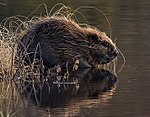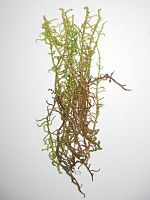Blue and Small Louder
|
FFH area "Blau und Kleine Lauter"
|
||
|
Small louder at Blaustein-Lautern |
||
| location | Alb-Donau-Kreis and Ulm , Baden-Wuerttemberg , Germany | |
| Identifier | DE-7524-341 | |
| WDPA ID | 555521956 | |
| Natura 2000 ID | DE7524341 | |
| FFH area | 16.26 km² | |
| Geographical location | 48 ° 25 ' N , 9 ° 54' E | |
|
|
||
| Setup date | January 1, 2005 | |
| administration | Regional Council Tübingen | |
| particularities | 12 sub-areas | |
The FFH area Blau and Kleine Lauter is located in the east of Baden-Württemberg and is part of the European Natura 2000 network of protected areas . It was designated in 2005 by the Tübingen regional council.
location
The approximately 1626 hectare protected area Blau and Kleine Lauter is located in the natural areas of the Middle Area Alb and the Lonetal Area Alb . Its 12 sub-areas are located in the municipalities of Berghülen , Blaubeuren , Blaustein and Dornstadt in the Alb-Danube district and in the independent city of Ulm .
description
The nature of the landscape of the protected area is essentially shaped by the valleys of the Kleine Lauter and the Blau . It covers the entire course of both rivers to the urban area of Ulm. The floodplains of both bodies of water are largely free of forests and characterized by grassland. The valley flanks are characterized by open grasslands and juniper heaths or near-natural forests and interspersed with numerous rock formations.
In the Arnegger Ried there are remains of a transitional and vibrating lawn bog.
Both streams are habitat for several strictly protected species such as the brook lamprey and bullhead .
Protection purpose
Habitat types
The following habitat types according to Annex I of the Habitats Directive occur in the area:
| EU code |
* | Habitat type (official name) | Short name |
|---|---|---|---|
| 3150 | Natural eutrophic lakes with magnopotamion or hydrocharition vegetation | Natural nutrient-rich lakes | |
| 3260 | Rivers of the planar to montane level with vegetation of the Ranunculion fluitantis and the Callitricho-Batrachion | Running waters with flooding aquatic vegetation | |
| 40A0 | * | Subcontinental peripannonian bushes | Rock cherry bushes |
| 5130 | Formations of Juniperus communis on limestone heaths and lawns | Juniper Heath | |
| 6110 | * | Gap basophilic or lime pioneer lawn (Alysso-Sedion albi) | Lime pioneer lawn |
| 6210 | Near-natural dry lime lawns and their stages of shrubbery (Festuco-Brometalia) | Lime grassland | |
| 6430 | Moist tall herbaceous vegetation of the planar and montane to alpine level | Moist tall herbaceous vegetation | |
| 6510 | Lean lowland hay meadows (Alopecurus pratensis, Sanguisorba officinalis) | Lean, lowland hay meadows | |
| 7140 | Transitional and swinging lawn bogs | Transitional and rocking bogs | |
| 8160 | * | Calcareous debris heaps of the colline to montane level of Central Europe | Lime debris heaps |
| 8210 | Limestone cliffs with crevice vegetation | Limestone cliffs with crevice vegetation | |
| 8310 | Caves that are not open to tourists | Caves and balms | |
| 9130 | Woodruff beech forest (Asperulo-Fagetum) | Woodruff beech forest | |
| 9150 | Central European orchid-lime-beech forest (Cephalanthero-Fagion) | Orchid beech forests | |
| 9180 | * | Mixed ravine and hillside forests (Tilio-Acerion) | Mixed ravine and hillside forests |
| 91E0 | * | Alluvial forests with Alnus glutinosa and Fraxinus excelsior (Alno-Padion, Alnion incanae, Salicion albae) | Alluvial forests with alder, ash, willow |
Species inventory
The following types of community interest exist in the area:
| image | EU code |
* | Art | scientific name | Species group |
|---|---|---|---|---|---|

|
1014 | Narrow diaper snail | Vertigo angustior | Snails | |

|
1078 | * | Spanish flag | Callimorpha quadripunctaria | Butterflies |

|
1096 | Brook lamprey | Lampetra planeri | Fish and round mouths | |

|
1163 | Bullhead | Cottus gobio | Fish and round mouths | |

|
1166 | Crested newt | Triturus cristatus | Amphibians | |

|
1193 | Yellow-bellied toad | Bombina variegata | Amphibians | |

|
1323 | Bechstein's bat | Myotis bechsteinii | Mammals | |

|
1324 | Great mouse ear | Myotis myotis | Mammals | |

|
1337 | beaver | Castor fiber | Mammals | |

|
1381 | Green broom moss | Dicranum viride | Mosses | |

|
1381 | Glossy sickle moss | Drepanocladus vernicosus | Mosses |
Contiguous protected areas
The following nature reserves are part of the FFH area:
See also
Individual evidence
- ↑ a b c Tübingen regional council (ed.): Management plan for the FFH area 7524-341 “Blau und Kleine Lauter” . edited by the planning office PAN GmbH, Munich. September 20, 2019 (214 pages, baden-wuerttemberg.de [PDF]).
Web links
- Standard data sheet for the FFH area "Danube between Munderkingen and Ulm and northern Iller"
- Profile of the FFH area Blau and Kleine Lauter in the protected area directory of the LUBW
- Regional Council Tübingen (ed.): Management plan for the FFH area 7524-341 "Blau und Kleine Lauter" . edited by the planning office PAN GmbH, Munich. September 20, 2019 (214 pages, baden-wuerttemberg.de [PDF]).

